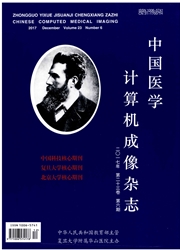

 中文摘要:
中文摘要:
目的:探讨计算机辅助MRI三维重建在肝转移瘤微波消融术前计划及术后随访中的作用。方法:2015年8月至2016年5月我院收治符合肝微波消融适应证的肝转移瘤患者16例(21个病灶)。术前采用MRI及后处理站进行多维度、多序列(T1WI增强、T2WI及DWI)3D重建观察目标病灶及周围环境,综合多方面因素考虑制订术前穿刺及消融计划;术中实时利用3D重建技术,以垂直于穿刺针平面进行实时追踪并评估穿刺途径及消融范围,术后采用同一平面利用T2WI、T1WI增强及DWI成像评估术后消融范围及效果。结果:手术均顺利完成,无明显并发症,随访至术后1~3个月未见明显复发征象。其中14例术前行肝脏CTA检查(检出病灶17个),与CTA相比,TIWI-MRI3D重建显示病灶周边血管(三级及三级以上分支)为29/30,显示率为99%;所有病例未见明显胆管扩张,术前T2WI显示病灶邻近lcm内二级胆管分支共12例。根据术前规划、模拟穿刺途径,与实际穿刺途径符合100%,术后3D重建显示消融范围完全覆盖肿瘤边界。结论:计算机辅助MRI评价体系可有效评价目标病灶的大小及周边环境,为术前拟定手术方案提供依据;术中可有效引导穿刺并实施多维度展现术区变化,评估消融范围;术后及随访可有效多序列展示消融边界及信号变化,提供多方位信息。
 英文摘要:
英文摘要:
Purpose: To verify the feasibility of MRI three-dimensional (3D) reconstruction in planning and evaluating the treatment response of liver metastasis microwave ablation (MWA). Methods: From Aug 2015 to May 2016, according to the selection criteria, 16 patients (21 lesions) were enrolled. MRI exam (T1WI, T2WI, multi-b value DWI) were performed before the operation and also for the follow-up. All data were transferred to the workstation, and post-procession was done. Results: Till 1-3 month after operation, no serious or fatal complication, no recurrence was observed. The operation trace was 100% matched with the 3D reconstruction planning. Compared with CTA, 99% (29/30) small vessels were shown by MRI. No biliary duct dilation was shown in all cases; MRI showed 12 normal biliary ducts. PostSoperation signal change and ablation margin were shown by MRI 3D reconstruction. Conclusion: MRI 3D reconstruction is feasible and effective in the treatment planning and evaluating the treatment response of MWA for liver metastasis.
 同期刊论文项目
同期刊论文项目
 同项目期刊论文
同项目期刊论文
 期刊信息
期刊信息
